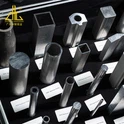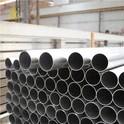Effect and influence of various elements in aluminum alloy on properties of aluminum
Copper element
When the aluminum-copper alloy is rich in aluminum portion 548, the maximum solubility of copper in aluminum is 5.65%, and when the temperature is lowered to 302, the solubility of copper is 0.45%. Copper is an important alloying element and has a certain solid solution strengthening effect. In addition, CuAl2 precipitated by aging has obvious aging strengthening effect. The copper content in aluminum alloys is usually between 2.5% and 5%, and the copper content is best at 4% to 6.8%, so the copper content of most hard aluminum alloys is in this range.
Silicon element
At the eutectic temperature of 577 in the Al-Si alloy-rich aluminum portion, the maximum solubility of silicon in the solid solution is 1.65%. Although the solubility decreases with decreasing temperature, such alloys are generally not heat treatable. Aluminum-silicon alloys have excellent casting properties and corrosion resistance.
If magnesium and silicon are simultaneously added to aluminum to form an aluminum-magnesium-silicon alloy, the strengthening phase is MgSi. The mass ratio of magnesium to silicon is 1.73:1. When the Al-Mg-Si alloy composition is designed, the contents of magnesium and silicon are arranged in this ratio on the substrate. In some Al-Mg-Si alloys, in order to increase the strength, an appropriate amount of copper is added, and an appropriate amount of chromium is added to offset the adverse effect of copper on corrosion resistance.
Al-Mg2Si alloy alloy equilibrium phase diagram The maximum solubility of Mg2Si in aluminum is 1.85%, and the deceleration is small with decreasing temperature.
In the deformed aluminum alloy, silicon is added to aluminum alone and is limited to the welding material, and silicon is also added to aluminum to have a certain strengthening effect.
Magnesium
The equilibrium phase diagram of the Al-Mg alloy is rich in aluminum. Although the solubility curve indicates that the solubility of magnesium in aluminum is greatly reduced with temperature, in most industrially deformed aluminum alloys, the content of magnesium is less than 6%. The silicon content is also low, and these alloys are not heat-treated, but have good weldability, good corrosion resistance, and moderate strength.
The strengthening of magnesium by aluminum is obvious. For every 1% increase in magnesium, the tensile strength is about 34 MPa. If less than 1% manganese is added, it may be supplemented with strengthening. Therefore, the addition of manganese can reduce the magnesium content, and at the same time reduce the tendency of hot cracking. In addition, manganese can uniformly precipitate the Mg5Al8 compound to improve the corrosion resistance and the welding performance.
Manganese element
In the equilibrium phase diagram of the Al-Mn alloy system, the maximum solubility of manganese in the solid solution was 1.82% at the eutectic temperature of 658. The strength of the alloy increases with increasing solubility. When the manganese content is 0.8%, the elongation reaches a maximum. The Al-Mn alloy is a non-aging hardening alloy, that is, it cannot be heat-treated.
Manganese can prevent the recrystallization process of aluminum alloys, increase the recrystallization temperature, and refine the recrystallized grains remarkably. The refinement of recrystallized grains is mainly caused by the diffusion of particles of MnAl6 compound to hinder the growth of recrystallized grains. Another function of MnAl6 is to dissolve the impurity iron and form (Fe, Mn)Al6 to reduce the harmful effects of iron.
Manganese is an important element of aluminum alloy, and it can be added separately to form an Al-Mn binary alloy, and more is added together with other alloying elements, so that most of the aluminum alloys contain manganese.
Zinc element
Al-Zn alloy equilibrium phase diagram The solubility of zinc in aluminum is 31.6% in the aluminum-rich fraction 275, while its solubility decreases to 5.6% at 125.
Zinc is added to aluminum alone. Under the deformation condition, the strength of the aluminum alloy is very limited, and there is a tendency of stress corrosion cracking, which limits its application.
Simultaneous addition of zinc and magnesium in aluminum forms a strengthening phase Mg/Zn2, which has a significant strengthening effect on the alloy. When the Mg/Zn2 content is increased from 0.5% to 12%, the tensile strength and yield strength can be significantly increased. The content of magnesium exceeds that of the superhard aluminum alloy required to form the Mg/Zn2 phase. When the ratio of zinc to magnesium is controlled at about 2.7, the stress corrosion cracking resistance is the largest.
For example, by adding copper element to Al-Zn-Mg to form an Al-Zn-Mg-Cu alloy, the base strengthening effect is the largest among all aluminum alloys, and is also an important aluminum alloy material in the aerospace, aviation industry, and electric power industries.










